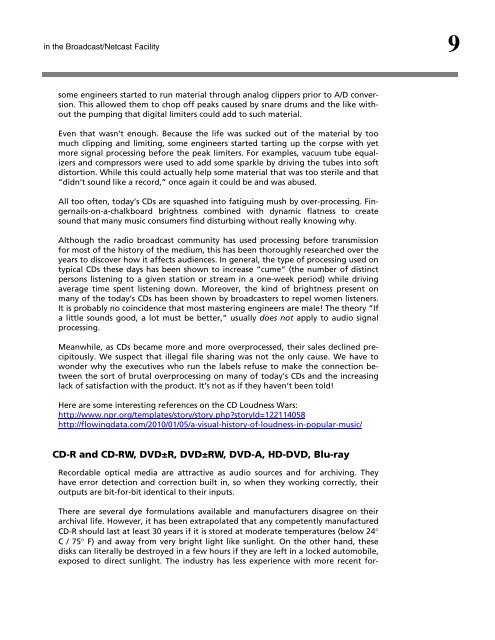Maintaining Audio Quality in the Broadcast Facility 2011 - Orban
Maintaining Audio Quality in the Broadcast Facility 2011 - Orban
Maintaining Audio Quality in the Broadcast Facility 2011 - Orban
You also want an ePaper? Increase the reach of your titles
YUMPU automatically turns print PDFs into web optimized ePapers that Google loves.
<strong>in</strong> <strong>the</strong> <strong>Broadcast</strong>/Netcast <strong>Facility</strong> 9<br />
some eng<strong>in</strong>eers started to run material through analog clippers prior to A/D conversion.<br />
This allowed <strong>the</strong>m to chop off peaks caused by snare drums and <strong>the</strong> like without<br />
<strong>the</strong> pump<strong>in</strong>g that digital limiters could add to such material.<br />
Even that wasn’t enough. Because <strong>the</strong> life was sucked out of <strong>the</strong> material by too<br />
much clipp<strong>in</strong>g and limit<strong>in</strong>g, some eng<strong>in</strong>eers started tart<strong>in</strong>g up <strong>the</strong> corpse with yet<br />
more signal process<strong>in</strong>g before <strong>the</strong> peak limiters. For examples, vacuum tube equalizers<br />
and compressors were used to add some sparkle by driv<strong>in</strong>g <strong>the</strong> tubes <strong>in</strong>to soft<br />
distortion. While this could actually help some material that was too sterile and that<br />
“didn’t sound like a record,” once aga<strong>in</strong> it could be and was abused.<br />
All too often, today’s CDs are squashed <strong>in</strong>to fatigu<strong>in</strong>g mush by over-process<strong>in</strong>g. F<strong>in</strong>gernails-on-a-chalkboard<br />
brightness comb<strong>in</strong>ed with dynamic flatness to create<br />
sound that many music consumers f<strong>in</strong>d disturb<strong>in</strong>g without really know<strong>in</strong>g why.<br />
Although <strong>the</strong> radio broadcast community has used process<strong>in</strong>g before transmission<br />
for most of <strong>the</strong> history of <strong>the</strong> medium, this has been thoroughly researched over <strong>the</strong><br />
years to discover how it affects audiences. In general, <strong>the</strong> type of process<strong>in</strong>g used on<br />
typical CDs <strong>the</strong>se days has been shown to <strong>in</strong>crease “cume” (<strong>the</strong> number of dist<strong>in</strong>ct<br />
persons listen<strong>in</strong>g to a given station or stream <strong>in</strong> a one-week period) while driv<strong>in</strong>g<br />
average time spent listen<strong>in</strong>g down. Moreover, <strong>the</strong> k<strong>in</strong>d of brightness present on<br />
many of <strong>the</strong> today’s CDs has been shown by broadcasters to repel women listeners.<br />
It is probably no co<strong>in</strong>cidence that most master<strong>in</strong>g eng<strong>in</strong>eers are male! The <strong>the</strong>ory “If<br />
a little sounds good, a lot must be better,” usually does not apply to audio signal<br />
process<strong>in</strong>g.<br />
Meanwhile, as CDs became more and more overprocessed, <strong>the</strong>ir sales decl<strong>in</strong>ed precipitously.<br />
We suspect that illegal file shar<strong>in</strong>g was not <strong>the</strong> only cause. We have to<br />
wonder why <strong>the</strong> executives who run <strong>the</strong> labels refuse to make <strong>the</strong> connection between<br />
<strong>the</strong> sort of brutal overprocess<strong>in</strong>g on many of today’s CDs and <strong>the</strong> <strong>in</strong>creas<strong>in</strong>g<br />
lack of satisfaction with <strong>the</strong> product. It’s not as if <strong>the</strong>y haven’t been told!<br />
Here are some <strong>in</strong>terest<strong>in</strong>g references on <strong>the</strong> CD Loudness Wars:<br />
http://www.npr.org/templates/story/story.php?storyId=122114058<br />
http://flow<strong>in</strong>gdata.com/2010/01/05/a-visual-history-of-loudness-<strong>in</strong>-popular-music/<br />
CD-R and CD-RW, DVD±R, DVD±RW, DVD-A, HD-DVD, Blu-ray<br />
Recordable optical media are attractive as audio sources and for archiv<strong>in</strong>g. They<br />
have error detection and correction built <strong>in</strong>, so when <strong>the</strong>y work<strong>in</strong>g correctly, <strong>the</strong>ir<br />
outputs are bit-for-bit identical to <strong>the</strong>ir <strong>in</strong>puts.<br />
There are several dye formulations available and manufacturers disagree on <strong>the</strong>ir<br />
archival life. However, it has been extrapolated that any competently manufactured<br />
CD-R should last at least 30 years if it is stored at moderate temperatures (below 24�<br />
C / 75� F) and away from very bright light like sunlight. On <strong>the</strong> o<strong>the</strong>r hand, <strong>the</strong>se<br />
disks can literally be destroyed <strong>in</strong> a few hours if <strong>the</strong>y are left <strong>in</strong> a locked automobile,<br />
exposed to direct sunlight. The <strong>in</strong>dustry has less experience with more recent for-



![[PDF] Using the ITU BS.1770-2 and CBS Loudness Meters ... - Orban](https://img.yumpu.com/50629372/1/190x245/pdf-using-the-itu-bs1770-2-and-cbs-loudness-meters-orban.jpg?quality=85)






![[PDF] Optimod-FM Feature Comparison - Orban](https://img.yumpu.com/41741615/1/190x245/pdf-optimod-fm-feature-comparison-orban.jpg?quality=85)






